It’s pretty common when your CPU clock speed jumps ups and down in the standard margin. But when your CPU clock speed jumps abnormally like a severe patient’s bpm in the Holter monitor, it’s a matter of concern.
Among many reasons, overclocking a CPU sometimes brings chaos to the PC at times and makes your CPU unstable.
So, let’s begin dissecting the core facts of the fluctuating CPU clock speed. Plus, follow the fixes in this article to resolve abnormal CPU clock frequency jumping. Let’s begin!
Let’s begin!
What is CPU Clock Speed?
The clock speed or frequency of a CPU mainly represents the number of cycles a CPU executes per second. The frequency is measured in GHz (Gigahertz). The main fact is a powerful CPU is known for its higher clock speed. For example, a 3.7 GHz CPU is more powerful than a 2.8 GHz CPU.
If you compare the system with a human body, the CPU is the brain, and its clock speed is the timeframe to think. Today’s CPU can execute these cycles per second in billions.
As the CPU has to handle all the mathematical calculations, each cycle can execute a complex equation, sometimes multiple. The task handler efficiency mainly depends on the capability of the processor.
Can a multicore processor with a lower base frequency surpass a higher clock speed with a fewer core-based CPU?
The answer is Yes. Today’s lower frequency-based multicore CPU can compete against a four-year-old higher clock speed-based CPU with fewer cores. And the award goes to improved processor handling programming and multicores.
Despite having a lower base clock speed, the multicores uplift the performance significantly. That’s why modern gen processors are a true gem!
There is a difference between the base clock speed and boosted clock speed. When the CPU handles moderate apps, it executes all the tasks using the base speed. And for high CPU-intensive tasks, it bumped the core clock speed to the maximum boosted frequency.
Is Frequent CPU Clock Speed Switching a Problem?
CPU clock speed changing is normal, and if it’s not changed, it can be a sign of a problem with the CPU. A CPU’s frequency can jump up and down if it has to handle many workloads. A CPU clock speed will jump from the base to boost to handle highly intensive workloads.
That’s why CPU clocks do change frequently, and it’s natural. As you know, clock speed refers to the number of cycles a CPU executes in a second. That’s why clock speed varies from time to time while executing tasks.
Assume your PC is idle and the CPU clock speed is under the base clock speed to save power. When you execute any simple task, the clock speed will spike at that instance to execute the task faster, like jumping from 2.2 GHz to 3.4 GHz.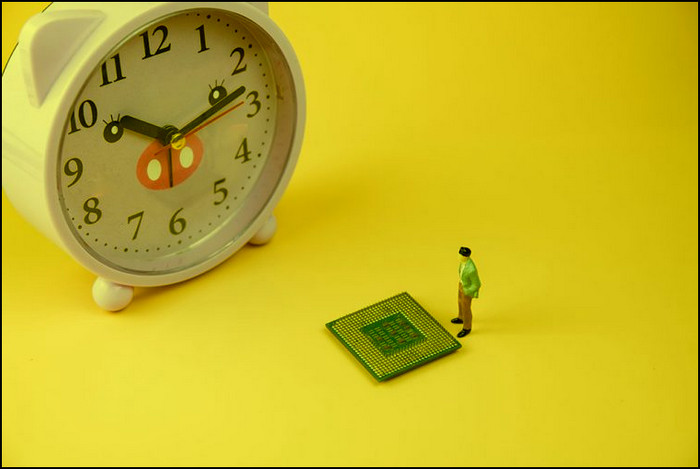 Plus, the frequency will spike to the max clock speed if you execute some high CPU-intensive workloads. I hope now you know why your CPU clock frequency keeps changing.
Plus, the frequency will spike to the max clock speed if you execute some high CPU-intensive workloads. I hope now you know why your CPU clock frequency keeps changing.
The GHz does matter in the CPU to deliver a sheer amount of performance and will jump around based on the workload.
Why is CPU Clock Speed Changing Abnormally?
Among several factors, overclocking, CPU performance set to max, or heat mitigation failures are mainly responsible for CPU clock speed changing abnormally. However, if required, Intel’s turbo boost technology or AMD’s precision boost can increase clock speed.
Here are the main reasons behind CPU clock speed is changing abnormally:
Overclocking
Overclocking means forcing your CPU to surpass the boosted clock speed. If you overclocked your CPU, then it might be the reason behind the CPU clock speed being spiked up in the idle state.
Overclocking the CPU by passing excessive voltage can sometimes create problems like CPU core frequency hitting the ceiling. Using the CPU all time with the maximum clock speed can cause damage to the CPU. For this reason, you might face abnormal CPU clock spikes.
For this reason, you might face abnormal CPU clock spikes.
When it comes to overclocking, things can become complicated in BIOS. To simplify this, we have done a separate piece where we give you detailed instructions to overclock your CPU without BIOS. Do take a look.
Modified Processor State
In Windows, there is a Processor Power Management setting in the Power Options under the Control Panel. If you have increased the percentage too high for the minimum processor state, you’ll see the CPU clock is high all the time.
You can modify the processor power state for the Plugged in and On battery state condition if you’re using a laptop. For desktop, you can change the CPU usage for only one state, you won’t see the options like the Plugged in and On battery.
Heat Mitigation Failure
Heat is the main culprit for provoking the CPU performance issue. When the CPU generates too much, you’ll see a slow-down performance, and that’s when the clock speed drops down.
When the CPU starts to cool down, the performance increases too. If the heat can’t dissipate from the CPU properly, you’ll surely notice abnormal clock speed.
If you incorrectly set up the exhaust fans, the hot air won’t flow outside the case. Instead, it will circle the case and make the CPU even hotter. Therefore, you’ll sometimes see the CPU frequency moving around randomly between 2.4 GHz and 4.0 GHz, which is unstable.
The frequency clock speed curve will look like mountains with random ups and downs. Many users reported that they faced a blue screen due to an overheated CPU.
Can overheating cause a blue screen? Well, it can, and you can fix it by cooling the CPU correctly.
How to Fix Spiked Clock Frequency When CPU is IDle
To fix the clock frequency when the CPU is idle, you can turn off the overclocking for the CPU. If you increase the minimum processor state from the Processor Power Management option, you must lower it. Plus, ensure a proper cooling system in the case.
You can also turn off the Intel speed step feature or turbo boost technology. If you’re an AMD processor user, you must turn off AMD precision boost. So, try these fixes to solve the CPU clock speed that keeps jumping while idle.
Here are the methods to fix spiked clock frequency when the CPU is idle:
1. Reduce CPU Usage from Processor Power Management
You can lower the minimum power state of the CPU when the PC is on the battery or in the charging state for laptops. But for desktops, you can reduce CPU usage under one state. So, follow the steps beneath the lower minimum power state by going to the Control Panel.
Follow the below instructions to reduce the CPU usage from the Processor power management:
- Launch Control Panel and click on Power Options.
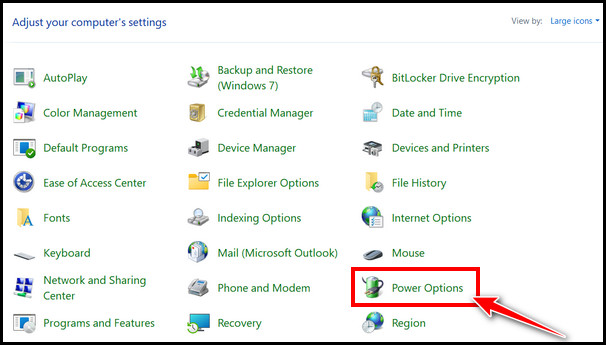
- Select Change plan settings beside the Balanced option.
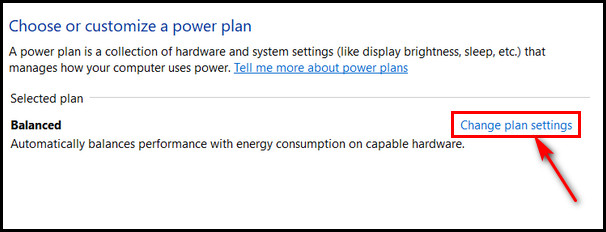
- Choose Change advanced power settings.
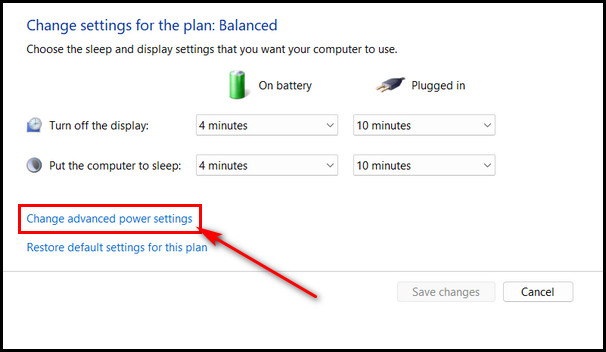
- Click to maximize the Processor power management option.
- Lower the percentage from the Minimum processor state & Maximum processor state.
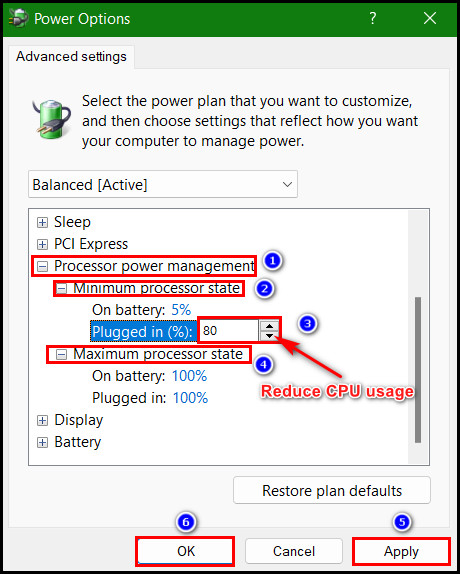
- Reduce the CPU usage in percentage from the Settings section if you’re using a desktop.
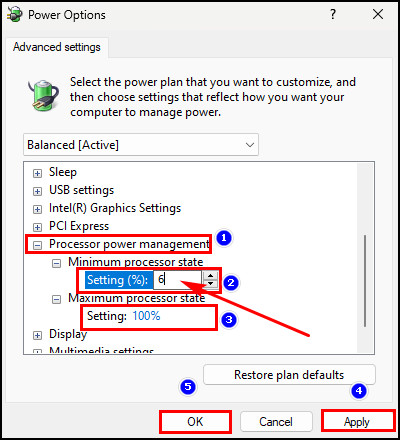
- Decrease the percentage from both the On battery & Plugged in sections if you’re using a laptop.
- Hit Apply > OK.
After this, restart the PC and check CPU usage from the Task Manager. Now you’ll find reduced CPU usage by reducing the clock speed.
If your processor does not receive enough power to run it is known as power throttling. You can learn more about CPU power throttling in a separate article that we have covered.
2. Turn Off Overclocking
If you’re facing maxed-out clocked speed, even if the CPU is idle after overclocking the CPU, you should turn it down now. Overclocking a CPU requires perfect voltage pushing to the CPU cores.
When you set the voltage to more than the required amount, it will make the CPU unstable. That’s when the CPU clock speed fluctuates abnormally, even maxed out all the time. So, turn off overclocking or push the accurate voltage to the CPU.
To get the maxed-out performance, you can overclock RAM too. Overclocking DDR4 RAM will make your PC faster than before.
You should also know how much voltage a CPU can take & how much voltage you should while overclocking before overclocking it. It will help you to overclock a CPU perfectly.
3. Set Balanced Power Mode from Windows Settings
There is a Balanced option in the Power Mode settings under Windows Settings. It will help you to lower the CPU frequency by using only a minimum amount of the CPU clock speed.
Follow the below steps to set Balanced power mode from Windows settings:
- Press Windows + I to Go to Windows settings.
- Navigate to System > Power & battery.
- Choose the Balanced or Best power efficiency option from the Power mode.
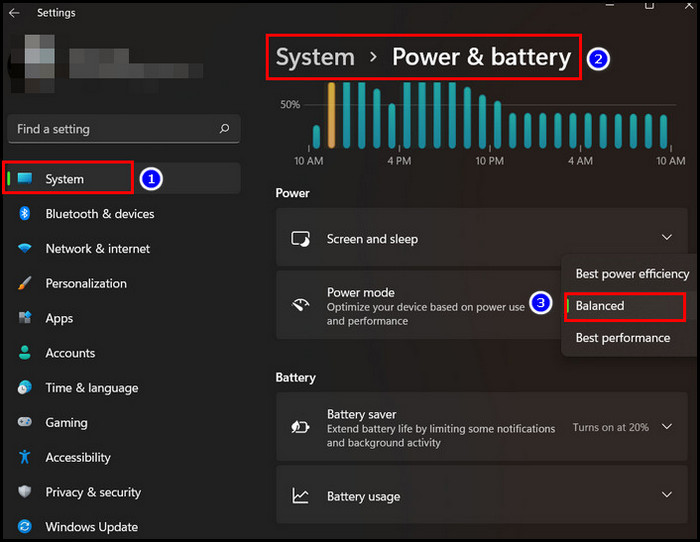
Note: The Power mode is only available for laptops that are running on the latest Windows version. You won’t see that feature on Windows desktops.
It will force the CPU to avoid using the high clock speed all the time. So, applying all the above fixes will fix the CPU running at the maximum clock speed, even in the idle state.
FAQs
Why is my CPU clock speed jumping?
CPU clock speed jumps from high to low, which is normal. The CPU pushes itself to the max when apps go through an intensive workload. Sometimes issues like CPU throttling cause the clock speed to fluctuate.
Why does my CPU clock speed keep spiking?
CPU clock speed spikes due to overclocking, highly intensive background tasks, tweaked performance settings, or heat mitigation failure. So, look for the leading cause and fix it by performing the required steps.
Is high-frequency good for the CPU?
Speaking frankly, the more the frequency, the better is performance. The high frequency is good for the CPU to handle any task with ease. But maintaining high speed all the time will damage it over time.
What is the normal CPU frequency?
Clock speed between 3.5 and 4.0 GHz is good for gaming and high-level app usage. But it mainly depends on how your CPU handles single-threaded performance.
Final Thoughts
Many processes keep running in the background, and the CPU has to handle all those tasks. That’s why CPU frequency keeps jumping forward and backward, which is not an issue.
I have shown all the factors of why CPU clock speed keeps fluctuating. But sometimes, the frequency can increase or decrease abnormally for several reasons. So, follow the fixes from this article.
For more help regarding CPU, don’t forget to knock me in the comment box below.




